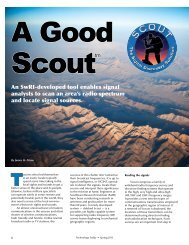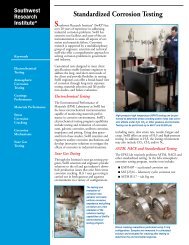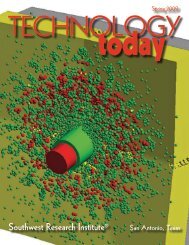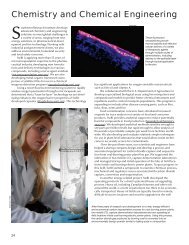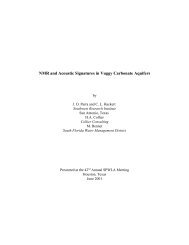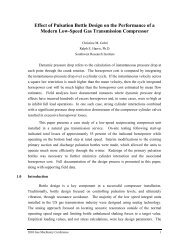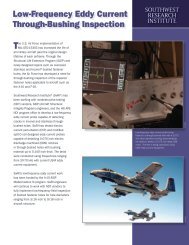Technology Today - Southwest Research Institute
Technology Today - Southwest Research Institute
Technology Today - Southwest Research Institute
You also want an ePaper? Increase the reach of your titles
YUMPU automatically turns print PDFs into web optimized ePapers that Google loves.
D017278<br />
The New Horizons spacecraft captured this image of Jupiter’s moons Io<br />
(right) and Europa as it passed the giant gas planet in 2007. Three plumes<br />
from active volcanoes are visible on Io.<br />
Courtesy NASA/JHU APL/SwRI<br />
Outer Solar<br />
System<br />
SwRI space science is<br />
active beyond the asteroid<br />
belt, in the realm of the<br />
giant planets and beyond. The New<br />
Horizons mission to Pluto was conceived<br />
at SwRI-Boulder and launched toward<br />
Pluto in January 2006. The spacecraft is<br />
now well beyond the orbit of Saturn, and<br />
will fly past Pluto and its moons Charon,<br />
Nix and Hydra (the last two co-discovered<br />
by Boulder staff) in July 2015, greatly<br />
improving our understanding of these<br />
worlds and icy dwarf planets in general.<br />
New Horizons made its first discoveries<br />
in early 2007, when it flew past<br />
Jupiter at a range of 2 million km and<br />
used the giant planet’s gravity to speed<br />
the journey to Pluto. The spacecraft’s<br />
images of Jupiter itself revealed new<br />
details of its complex storm systems,<br />
including unprecedented near-infrared<br />
time-lapse views of ammonia-rich<br />
thunderstorms being torn apart by the<br />
planet’s intense winds. New Horizons<br />
obtained some of the best-ever images<br />
of Jupiter’s faint ring system, discovering<br />
a series of mysterious clumps of ring<br />
material. Images of its volcanic moon Io<br />
documented an enormous eruption from<br />
the volcano Tvashtar, obtaining movies<br />
of its 350-km-high plume. These close-up<br />
observations were supplemented using<br />
the Hubble Space Telescope and<br />
ground-based telescopes.<br />
The peculiar<br />
lumpy atmosphere of Io<br />
and charged particles<br />
that escape Io and fill the<br />
Jovian magnetosphere<br />
are subjects of additional<br />
ground-based and spacecraft<br />
investigations.<br />
Even as it awaits the<br />
New Horizons flyby,<br />
Pluto is under regular<br />
scrutiny from Earth.<br />
Pluto’s atmosphere was discovered in<br />
1988 by means of stellar occultation, in<br />
which a planetary body passes between<br />
the observer and a background star. A<br />
subsequent pair of occultations in 2002<br />
revealed, surprisingly, that the atmospheric<br />
pressure had doubled despite Pluto’s<br />
increasing distance from the Sun. To<br />
further study these changes, the Boulder<br />
staff formed an occultation group in 2002,<br />
with members who have since traveled<br />
the world — wherever a star happens to<br />
cast Pluto’s shadow on the Earth —<br />
to record five subsequent Pluto<br />
occultations using a combination of<br />
local observatories and portable telescopes.<br />
These data are detailing changes<br />
in the structure, dynamics and shape<br />
of Pluto’s atmosphere, paving the way<br />
for New Horizons’ 2015 close-up view.<br />
Somewhat closer to home, NASA’s<br />
Cassini spacecraft has been orbiting<br />
the ringed planet Saturn since 2004,<br />
providing unprecedented information<br />
about the planet and its moons. Staff<br />
members have been involved both in<br />
planning Cassini’s observations and<br />
in understanding many facets of the<br />
data. In July 2005, Cassini’s Composite<br />
Infrared Spectrometer (CIRS) revealed<br />
enormous amounts of thermal radiation<br />
from tectonic fractures at the south pole<br />
of Saturn’s small moon Enceladus —<br />
one of a series of observations by multiple<br />
Cassini instruments that revealed<br />
Enceladus to be only the third world in<br />
the solar system, after Earth and Jupiter’s<br />
Io, known to be currently volcanically<br />
active. The high heat flux and geological<br />
Saturn’s narrow F ring and broad A ring were<br />
photographed by the Cassini spacecraft soon<br />
after Saturn’s August 2009 equinox. Shadows<br />
are cast onto the rings by thick clumps within<br />
or at the edges of empty gaps in the A ring.<br />
Courtesy NASA/JPL/SSI<br />
D017280<br />
4<br />
<strong>Technology</strong> <strong>Today</strong> • Winter 2009



